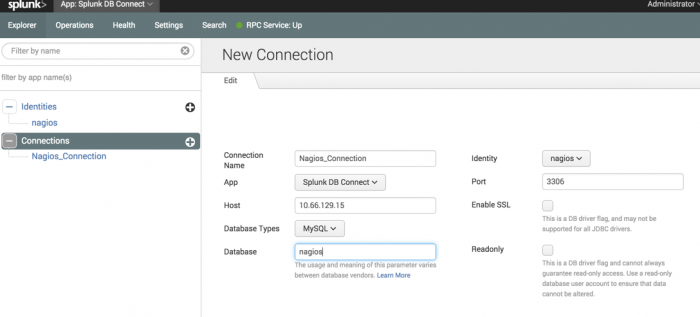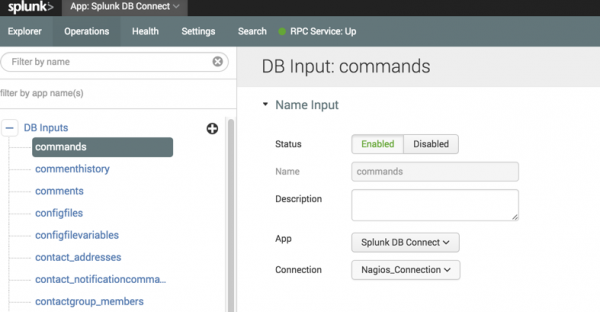Configure Splunk DB Connect v2 inputs for the Splunk Add-on for Nagios Core
Collect NDOUtils data via Splunk DB Connect on a heavy forwarder or search head. You must have an MySQL account with privileges to read the NDOUtils database, and the account must be connectable from the location of your data collection node.
These instructions apply only to Splunk DB Connect version 2.X. If you are using version 3.x, see Configure Splunk DB Connect v3 inputs for the Splunk Add-on for Nagios Core.
Configure NDOUtils inputs
- Add a Java mysql connector .jar file, such as
mysql-connector-java-5.1.34-bin.jar, into the folder$SPLUNK_HOME/etc/apps/splunk_app_db_connect/bin/lib. - Restart the Splunk platform.
- Create an identity in DB Connect. Use the username and password that you use when you log in to your NDOUtils MySQL database.

- Create a connection using the identity you just created using the name
Nagios_Connectionfor the connection. The database name is the one you specified when installing NDOUtils, and the account you use in the identity must have read privileges.
- If you use any connection name other than
Nagios_Connectionand/or the database name is notnagios, copy all the stanzas starting with with[mi_input://in$SPLUNK_HOME/etc/apps/Splunk_TA_nagios/default/inputs.conf.templateto$SPLUNK_HOME/etc/apps/splunk_app_db_connect/local/inputs.conf, and replace the connection name or database name, or both, in each stanza. See the stanza below to see the two places to change the connection name and the one place to change the default database name.[mi_input://instances] connection = <Change this to your custom connection name> index = main interval = 120 max_rows = -1 mode = batch output_timestamp_format = yyyy-MM-dd HH:mm:ss query = SELECT * FROM `<change this to your custom database name>`.`nagios_instances` source = dbx:<Change this to your custom connection name> sourcetype = nagios:instances ui_query_catalog = nagios ui_query_mode = simple ui_query_table = nagios_instances disabled = 1
- If you experience any problems while establishing the connection, check the MySQL account and the firewall settings on the machine running MySQL.
- To work around a known bug in Nagios regarding treatment of empty values for timestamps, add the following line exactly as written here to
$SPLUNK_HOME/etc/apps/splunk_app_db_connect/local/db_connection.conf.For more about the known bug in Nagios, see http://stackoverflow.com/questions/11133759/0000-00-00-000000-can-not-be-represented-as-java-sql-timestamp-error.jdbcUrlFormat = jdbc:mysql://<host>:<port>/<database>?zeroDateTimeBehavior=convertToNull
- Enable the desired input stanzas in DB Connect.

This documentation applies to the following versions of Splunk® Supported Add-ons: released
 Download manual
Download manual
Feedback submitted, thanks!